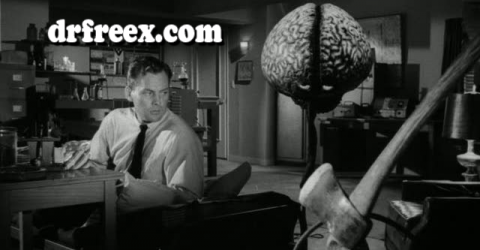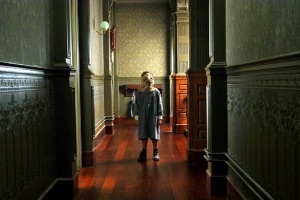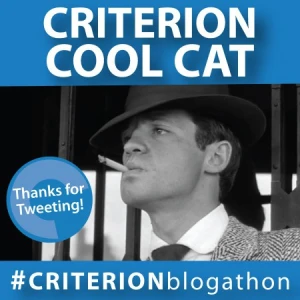 Tim Lucas starts out his typically excellent audio commentary for the recent Arrow Films restoration of Mario Bava’s Blood and Black Lace with an anecdote about Ernst Lubitsch. Apparently the director told a visitor to the set of Heaven Can Wait that Technicolor worked best with musicals and comedy, and should never be used for drama or mysteries. Lucas presents Blood and Black Lace as the prime exhibit that Lubitsch’s reasoning is incorrect. With the synchronicity that runs my life at this juncture, I watched another movie afterwards that also contested it, only earlier.
Tim Lucas starts out his typically excellent audio commentary for the recent Arrow Films restoration of Mario Bava’s Blood and Black Lace with an anecdote about Ernst Lubitsch. Apparently the director told a visitor to the set of Heaven Can Wait that Technicolor worked best with musicals and comedy, and should never be used for drama or mysteries. Lucas presents Blood and Black Lace as the prime exhibit that Lubitsch’s reasoning is incorrect. With the synchronicity that runs my life at this juncture, I watched another movie afterwards that also contested it, only earlier.
 Blood and Black Lace has followed me around all my life, it seems. It was released in the US in 1965, which would put me at eight years of age, already a veteran reader of Famous Monsters of Filmland; it made enough of a splash that I determined that this was something I needed to see. A bit of confusion led me, a few years later, to watch a late night TV showing of Blood and Roses (and talk about being even more confused later – I was much too young for Vadim, even edited for TV). So it’s actually taken me something like half a century to see this movie, and watching just the opening credits unfurl, all ravishing color and dark wit, lets me know the wait for this version was worth it. (This sequence was replaced for the American release with one by Filmation, included on the disc as an extra. Macabre, but much less colorful. Much.)
Blood and Black Lace has followed me around all my life, it seems. It was released in the US in 1965, which would put me at eight years of age, already a veteran reader of Famous Monsters of Filmland; it made enough of a splash that I determined that this was something I needed to see. A bit of confusion led me, a few years later, to watch a late night TV showing of Blood and Roses (and talk about being even more confused later – I was much too young for Vadim, even edited for TV). So it’s actually taken me something like half a century to see this movie, and watching just the opening credits unfurl, all ravishing color and dark wit, lets me know the wait for this version was worth it. (This sequence was replaced for the American release with one by Filmation, included on the disc as an extra. Macabre, but much less colorful. Much.)
I almost didn’t get to see it. This was supposed to be a high profile release from the new Arrow Video USA branch, but apparently the rights weren’t cleared up before the release was announced, and the title is on the “Indefinitely Delayed” list. Possibly as a cost-saving measure, though, the concurrent British release of the blu-ray was pressed for both Regions A & B, and I have this account with Amazon UK that proves very useful at times like this…
I think the difference in cost was like three bucks. The extra dough and extra wait were proven to be worthwhile in the first five seconds of the menu, which quotes the above-mentioned title sequence.
 Blood and Black Lace involves a series of murders decimating the models of a high fashion house in Rome. This may not be the first giallo movie (that title usually goes to director Mario Bava’s earlier, black-and-white The Girl Who Knew Too Much), but it is the one that codifies much of what would become the hallmarks of giallo: a series of sadistic murders, a black-gloved (and in this case, literally faceless) murderer, and innovative and stylish camerawork.
Blood and Black Lace involves a series of murders decimating the models of a high fashion house in Rome. This may not be the first giallo movie (that title usually goes to director Mario Bava’s earlier, black-and-white The Girl Who Knew Too Much), but it is the one that codifies much of what would become the hallmarks of giallo: a series of sadistic murders, a black-gloved (and in this case, literally faceless) murderer, and innovative and stylish camerawork.
The murders are extremely sadistic, though we don’t see a lot of gore; the victims are models, and the killer always seems to take special care to disfigure his victims. Bava started out as a lighting cameraman, and his ingenuity shines through, especially for such a low-budget movie. Unable to afford an expensive camera dolly and track, his artful, sweeping moves are accomplished with a child’s toy wagon. And the color! The phrase “color you could eat with a spoon” is a silly metaphor, but amazingly apt for this picture. It’s been plagued with substandard video releases to date, and small wonder, as the reds Bava employs would eat its way through any standard VHS tape.
 Lest one should think the color is a gimmick, Bava cagily uses the lack of it in his daytime scenes, always involving the police, who (as they must be in any giallo) are of very little help, hidebound in their dull little colorless world of procedures and guesswork. Killers and victims exist in a darker yet brighter world, candy-colored and fluorescent. Color is the province of the flamboyant, be they artists or madmen, and both revel in the night.
Lest one should think the color is a gimmick, Bava cagily uses the lack of it in his daytime scenes, always involving the police, who (as they must be in any giallo) are of very little help, hidebound in their dull little colorless world of procedures and guesswork. Killers and victims exist in a darker yet brighter world, candy-colored and fluorescent. Color is the province of the flamboyant, be they artists or madmen, and both revel in the night.
 Bava’s casting is also magnificent; Cameron Mitchell (who seems unrealistically young, at this far remove!), Eva Bartok, Luciano Pigozzi (whose full name should really be “Luciano Pigozzi, the Italian Peter Lorre”) and a number of remarkable women as the models, like Mary Arden (who had a remarkable life after), and my favorite, Harriet Medin, whose even more remarkable life Lucas expounds upon in the commentary. Here, she plays a housekeeper with some important red herring information. I instantly recognized her as Thomasina Paine in Death Race 2000.
Bava’s casting is also magnificent; Cameron Mitchell (who seems unrealistically young, at this far remove!), Eva Bartok, Luciano Pigozzi (whose full name should really be “Luciano Pigozzi, the Italian Peter Lorre”) and a number of remarkable women as the models, like Mary Arden (who had a remarkable life after), and my favorite, Harriet Medin, whose even more remarkable life Lucas expounds upon in the commentary. Here, she plays a housekeeper with some important red herring information. I instantly recognized her as Thomasina Paine in Death Race 2000.
The mystery itself plays fair with the viewer for the most part, although there is one bit when a character does something so inexplicable, it is almost certainly something Bava threw in to muddy the waters for the viewer. It’s not just a red herring (appropriate in this brightly colored milieu), it’s a big slab of what the hell that still leads to one of the most effective scenes, so we’ll just let it lie. Pondering the movie afterwards does provide a rationale for it, but it does require pondering. A very minor quibble to have this movie in such a bewitching presentation.
This is a very good disc, is what I’m saying. I’ve watched it twice so far, once to experience the movie, once to listen to Lucas’ commentary, and I’m trying to find time for a third run, this time with the English dub so I can enjoy Paul Frees being all the male characters. Does he voice Luciano Pigozzi The Italian Peter Lorre with an actual Peter Lorre? I need to know.
So I followed Blood and Black Lace up with another movie about sadistic murders, Peeping Tom, which could not be more different in tone, but no less artistic.
 Peeping Tom is largely famous for completely destroying the already sinking career of director Michael Powell, who is justly famous for movies like Black Narcissus, The Red Shoes, and The Life and Death of Colonel Blimp. These are all amazing, well-loved movies (and some would point out, made during his fruitful partnership with Emeric Pressburger). Peeping Tom is such an about-face from this earlier material, it seems almost an act of madness itself; that its initial withering critical reception and failure would, decades later, turn into rediscovery and reverence, is now a familiar, tragic tale.
Peeping Tom is largely famous for completely destroying the already sinking career of director Michael Powell, who is justly famous for movies like Black Narcissus, The Red Shoes, and The Life and Death of Colonel Blimp. These are all amazing, well-loved movies (and some would point out, made during his fruitful partnership with Emeric Pressburger). Peeping Tom is such an about-face from this earlier material, it seems almost an act of madness itself; that its initial withering critical reception and failure would, decades later, turn into rediscovery and reverence, is now a familiar, tragic tale.
In a reverse from Blood and Black Lace, we know who the killer is from the start: it’s Mark (Carl Boehm), a camera-obsessed, soft-spoken young man who A) works as a cameraman in a movie studio (giving Powell a chance to lampoon some of his friends/enemies over the years); B) Shoots pornographic photos, or in the parlance of the time, “views”, for a local newsagent; C) Rents out the rooms of his father’s spacious home; D) kills prostitutes while filming their death throes, using a camera tripod leg with a knife at the tip.
 There’s one facet of the murders that Powell hides from us until the very end, relying only on the police exclaiming over the look of extreme terror on the victims’ faces; we will see Mark is obsessed with fear, as he shows the nice young girl on the first floor, Helen (Anna Massey), the films his own father made of him when he was a child – his father awakening him in the middle of the night with lizards or bright lights, or forcing him to stand next to the dead body of his mother. This has created the monster he is today, watching the movies of his victims dying late at night, the footage he’s taken surreptitiously of the police investigations.
There’s one facet of the murders that Powell hides from us until the very end, relying only on the police exclaiming over the look of extreme terror on the victims’ faces; we will see Mark is obsessed with fear, as he shows the nice young girl on the first floor, Helen (Anna Massey), the films his own father made of him when he was a child – his father awakening him in the middle of the night with lizards or bright lights, or forcing him to stand next to the dead body of his mother. This has created the monster he is today, watching the movies of his victims dying late at night, the footage he’s taken surreptitiously of the police investigations.
The repulsion of the public to the movie may zero in on Boehm’s portrayal of Mark – though not wholly sympathetic, it is a quiet acting job, a damaged individual moving through a world that still confuses him on many levels. Anna Massey is quite remarkable as Helen, refreshingly unglamorous and real; her growing relationship with Mark offers an impossible rehabilitation, a normalcy he can hope for, but never truly achieve. When, after spending time with the bubbly Helen, we encounter more typical, idealistically beautiful movie women (and Mark’s chosen victims), they seem alien creatures, rare birds flitting through his world.
 One of these is Vivian, the stand-in for the vacuous star of the vapid comedy movie Mark is working on, who stays after hours to do a bit of film with the cameraman that she hopes will finally garner her the attention she needs to progress beyond stand-in work. Vivian is played by Moira Shearer, the star of Powell’s earlier The Red Shoes, and it’s hard not to read into her subsequent death the possibility of Powell murdering his own career. But that’s the sound of a guy putting way too much thought into his movie watching.
One of these is Vivian, the stand-in for the vacuous star of the vapid comedy movie Mark is working on, who stays after hours to do a bit of film with the cameraman that she hopes will finally garner her the attention she needs to progress beyond stand-in work. Vivian is played by Moira Shearer, the star of Powell’s earlier The Red Shoes, and it’s hard not to read into her subsequent death the possibility of Powell murdering his own career. But that’s the sound of a guy putting way too much thought into his movie watching.
 Peeping Tom, in keeping with its themes of voyeurism, is also one of the, if not the, first movie to give the audience the killer’s Point Of View during the murder scenes. They are seen, as by Mark, through the viewfinder of a camera, but that is not a fourth wall audiences of the time were expecting to crumble, or even wanted.
Peeping Tom, in keeping with its themes of voyeurism, is also one of the, if not the, first movie to give the audience the killer’s Point Of View during the murder scenes. They are seen, as by Mark, through the viewfinder of a camera, but that is not a fourth wall audiences of the time were expecting to crumble, or even wanted.
Peeping Tom opened in 1960, a few months before Psycho, a similar movie which is no less disturbing (and yes, there are parts of Peeping Tom that are legitimately hard to watch). Hitchcock recieved no such blowback from his seedy little horror movie. Is it because he was Hitchcock, a director who had never made a movie like Tales of Hoffman or A Matter of Life and Death? Or was it because Psycho was in black and white?
 Like Blood and Black Lace, Peeping Tom is in Eastmancolor, and though not as lurid as the op-art palette of Bava, this is still the director who manipulated color so brilliantly in Black Narcissus and The Red Shoes. The color here is lush and realistic, giving the world an unmistakable texture; it is no mistake that Mark’s murder movies are shot in black and white. Realistically, it’s a process he can perform in his own home darkroom, but in the world of this disturbed young man, it is also easily managed, stark. It allows him to concentrate on the fear of his victims, undistracted. And as I believe Hitchcock himself once stated about Psycho, black and white can be distancing, a reminder it’s only a movie. Or maybe it was Kubrick, talking about shooting Lolita in monochrome.
Like Blood and Black Lace, Peeping Tom is in Eastmancolor, and though not as lurid as the op-art palette of Bava, this is still the director who manipulated color so brilliantly in Black Narcissus and The Red Shoes. The color here is lush and realistic, giving the world an unmistakable texture; it is no mistake that Mark’s murder movies are shot in black and white. Realistically, it’s a process he can perform in his own home darkroom, but in the world of this disturbed young man, it is also easily managed, stark. It allows him to concentrate on the fear of his victims, undistracted. And as I believe Hitchcock himself once stated about Psycho, black and white can be distancing, a reminder it’s only a movie. Or maybe it was Kubrick, talking about shooting Lolita in monochrome.
I think Lubitsch’s point was Technicolor (or as seen here, Eastmancolor) is actually a hyperreal process; the colors it produces are gorgeous, but unrealistically vibrant, a method put to good use in lighthearted fare, fantasy. That is true for the most part, certainly true for Lubitsch and his works; but it is the role of artists to ignore such strictures. Without that defiance, we would never have any art at all.
The real kicker is neither of these movies is really available (in the forms I viewed) in the US. Blood and Black Lace for the reasons I mentioned above, and Peeping Tom… well, the rights currently belong to Studio/Canal, and all Amazon offers are Marketplace links to a Chinese blu-ray. A sad state of affairs for lovers of the beautiful… and the horrible.


























